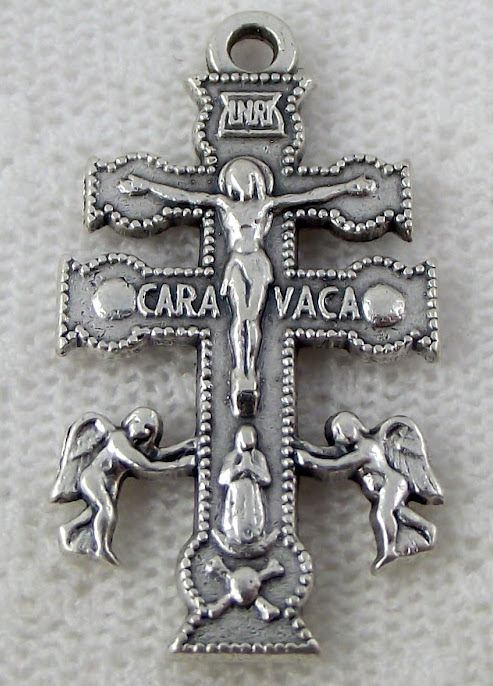
Caravaca de la Cruz
The Caravaca cross that is a cross with two horizontal arms symbolizes the second return of Jesus Christ in the form of Irineu to earth.
According to Jairo da Silva Carioca,
Mestre Irineu would preside while they sat around a table, in the form of a square, with the Caravaca Cross [1] -- first symbol of the doctrine that was already making part of the ritual -- placed at its center. The first spiritual works “were held at the house of Mestre; that little group, and he started to assist us,” remembers once more Mrs. Percília Matos (…) in this beginning the spoken word was therefore the greatest educational instrument. “He would lecture a lot, he would talk, give advice to us and would state how he wanted the work according to how the Virgin was teaching him,” comments Mrs. Maria Gomes. “Our work started as a class. You gather four, five kids, make a classroom and begin teaching, and more kids start to arrive. With the passing days the lessons also arrive, the teacher goes indicating how it is supposed to be, and the student goes about learning the ABC’s,” narrated Mr. José das Neves.
The cross of Caravaca is a double-cross-barred crucifx on which the figure of Jesus is flanked by two winged angels who kneel in postures of prayer. The arms of the saviour are nailed to the upper cross-bar, and the supplementary cross-bar projects widely to the sides. The original of this cross appeared miraculously in the Spanish town of Caravaca during the 14th century. It is said to contain a fragment of the True Cross upon which Jesus was crucified. Caravaca is known to archaeologists as the site of one of the oldest settlements in Spain, to occultists as a former stronghold of the mysterious Knights Templar, and to historians as a military fortress occupied during the struggle to oust the Moors and re-establish Christiantity in Spain.
In Mexico, the cross of Caravaca has been a popular religious amulet since colonial times. Some say that a copy of the original was the first Christian cross brought to Mexico, others tell me that the copy was brought to Mexico by Fr. Junipero Serra and carried by him as he travelled through Mexico and California. In either case, the cross of Caravaca is a major element in Mexican and Mexican-American religious folklore, where it is widely believed to have special powers to grant wishes and prayers.
The use of the cross of Caravaca for wish-fulfillment dates back at least to the the early 19th century. Documentation of a novena to San Roque, protector from fevers and epidemic diseases, notes that the pamphlet, published in Zacatecas, Mexico, in 1833, was illustrated with an image of this cross. (Full details can be found online under the title Diseases, Novenas, and Patron Saints in Nineteenth Century Zacatecas, by Alicia Bazarte Martinez, Instituto Politecnico Nacional.)
The cross of Caravaca commonly appears on the Mexican house and business charm known as El Secreto de la Virtuosa Herradura, where it is represented by a piece of gold-toned embossed paper pasted to a red cross-shaped paper, in turn pasted to a wooden cross positioned within an actual, used horseshoe which has been wrapped in red thread. The specific wish this amulet grants is financial success.
Stripped of its Catholic connotations, this same cross of Caravaca is often found in African-American hoodoo supply stores under the name "Wishing Cross." It is carried to ensure that a wish comes true, and is sometimes used in connection with herbal wish-fulmillment charms such as mojo wishing beans and Job's tears seeds.
The cross of Caravaca amulet shown here is made of gold-washed pot-metal and is 1" long, the size of a typical Mexian milagro. It is a variant of the original in that the upper cross-bar is embossed with the word "Caravaca," displacing the arms of Jesus to the lower cross-bar. This casting can also be found in the belly of the translucent plastic Mexican Buddha Preganant with a Cross, where it is accompanied by grains of rice and toxic abrus precatorius seeds. Similar cross of Caravaca charms from Mexico come in two sizes, 1" and 3" -- and on the larger one can be seen the embossed word "Caravaca" as well as images of the Virgin Mary and Archangel Michael with his upraised sword.
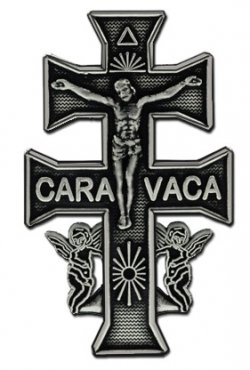
Caravaca de la Cruz is a beautiful town in the northwest of Murcia, in the mountains, and it has about 25,000 inhabitants. Towering above the town is the medieval Castle of Santa Cruz, that contains the miraculous True Cross, which is supposed to have a healing power, and in whose honor there is a yearly festival on May 3.
*the double beams cross, also known as the Caravaca Cross, probably brought to Brazil by the early missionaries, as it is also called the Missioner Cross, was the first symbol of the Santo Daime doctrine. By many is considered the true cross of Christ, for it would have been made with fragments of the cross on which Jesus was crucified. According to the elders, its meaning in the doctrine, represented by the two bars, is of the first and second coming of Christ on earth. This cross still today very popular in the North and Northeast of Brazil, where on April the 26th of 1500, four days after arriving in the New World, in a coral bank of the Red Crown's beach, in Bahia's Southern coast, was prayed an Easter Mass at the foot of a great cross, the first of many that have since been held in what came to become the largest Catholic country in the world.
*the double beams cross, also known as the Caravaca Cross, probably brought to Brazil by the early missionaries, as it is also called the Missioner Cross, was the first symbol of the Santo Daime doctrine. By many is considered the true cross of Christ, for it would have been made with fragments of the cross on which Jesus was crucified. According to the elders, its meaning in the doctrine, represented by the two bars, is of the first and second coming of Christ on earth. This cross still today very popular in the North and Northeast of Brazil, where on April the 26th of 1500, four days after arriving in the New World, in a coral bank of the Red Crown's beach, in Bahia's Southern coast, was prayed an Easter Mass at the foot of a great cross, the first of many that have since been held in what came to become the largest Catholic country in the world.
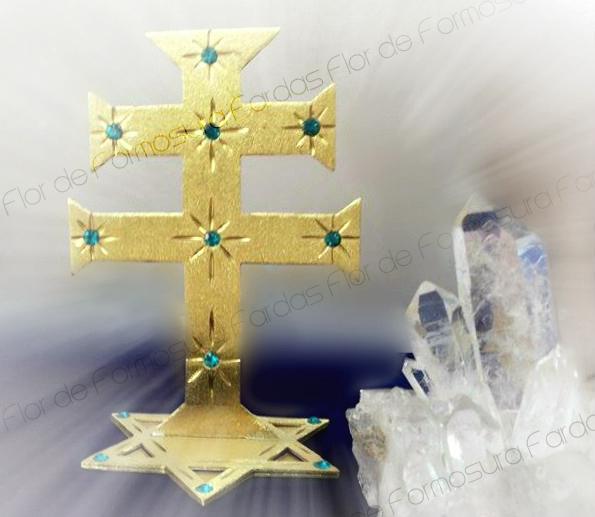
The legend of the Caravaca Cross is one of the most interesting stories. The cross is about a foot long and was used in the past to appear on the chests of ecclesiastical patriarchs. There are two horizontal bars on the cross. In 1232 a miracle occurred in the town. Murcia belonged to a Taifa kingdom of the Moors and the town was ruled by a Moorish king, Sayid Abu-Sayid. He was interviewing one of his Christian prisoners, a priest called Gines Perez Chirinos, who was from Cuenca. The king asked him about his profession and the priest told him that he said Mass. The king was curious and told him he wanted to see the priest say Mass at the main chamber of the fort, in front of the court. He arranged that the priest have an altar draped with a cloth, bread and wine, and some candles. However the priest said he could not proceed because he did not have a cross. Suddenly though the window of the chamber, two angels appeared with the True Cross, which they placed on the altar. The king and his whole court were so amazed by the miracle that they all asked to be baptized.
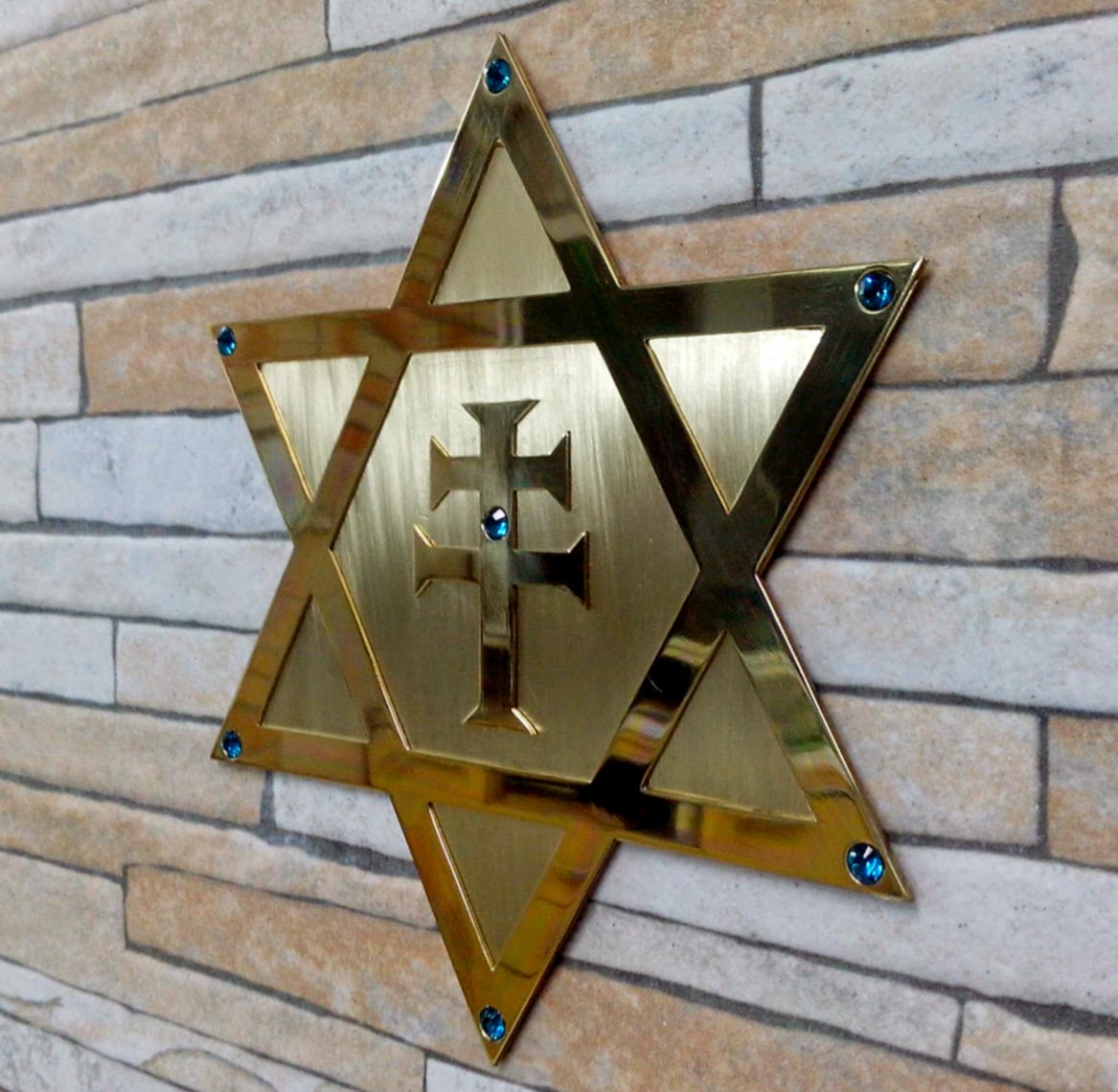
The Caravaca Cross is called a lignum crucis, because it contains a fragment of the True Cross on which Christ was crucified. Saint Helena, the mother of the Roman Emperor Constantine, was supposed to have found the true cross in Jerusalem in the 4th century. In 1099 this cross was owned by the patriarch Robert of Jerusalem. During the 6th Crusade, in 1230 when Jerusalem fell back into the hands of the Emperor Frederick II, the relic was in the possession of the bishop in that city. It then disappeared and suddenly appeared in Caravaca two years later. Today the town of Caravaca is the 3rd largest pilgrimage center in Spain because of the True Cross. When the Spanish landed in the Americas, the Franciscan missionaries brought copies of the Caravaca Cross to all parts of the New World, where it gained fame and devotion. It has become an amulet, to protect the wearer against all evil. Today it is the custom in Spain and other countries to give a small Caravaca Cross to friends as a symbol of affection, peace and love.
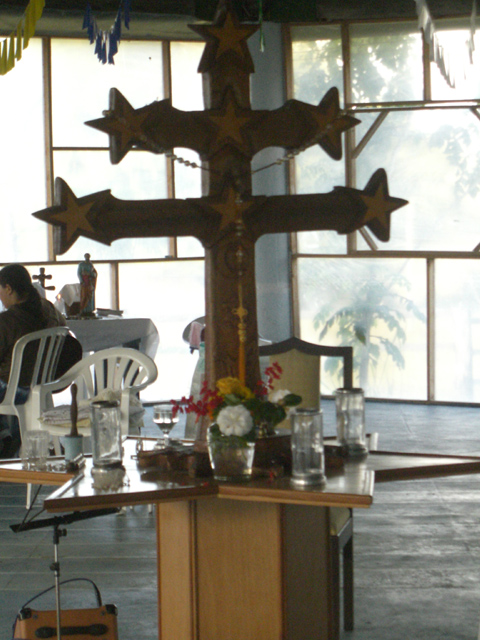
There is another legend about Caravaca. In the 15th century, the town passed to the Knights Templar, who built the castle that still stands over the town. At one time the Knights Templar and the people in the town took refuge in the castle when the Moors put it under siege. The water in the castle became unusable and many people fell sick. Some knights crept out of the castle at night to find water, but many of the neighboring wells had been poisoned by the Moors. The knights only found wine, which they put in wineskins and raced back to the castle on their horses. The Moors spotted them and raced after them, but the knights made it to the castle in time to save themselves. The wine was blessed in the presence of the Caravaca Cross and served to the people who were sick. These people recovered immediately, so the wine was mixed with the undrinkable water in the storage tanks. The water became fresh and the Christians were able to resist the enemy.
